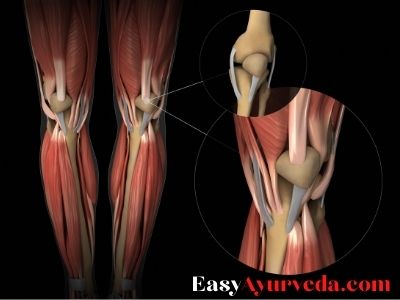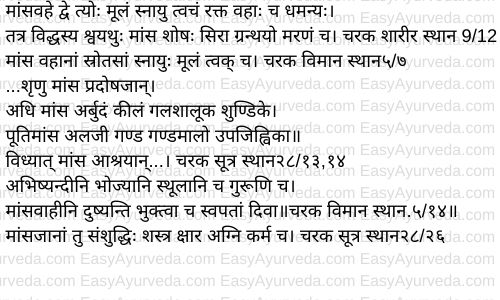Mamsavaha Srotas Description, Vitiation Symptoms, Treatment
By Dr Raghuram Y.S. MD (Ay) & Dr Manasa, B.A.M.S
Muscles are the important structures / tissues of the body which are responsible for all our movements on which almost all our daily activities depend upon. They form the important components of the musculoskeletal system.
Mamsa = muscles, Vaha = carrying, Srotas = channels / ducts of transportation or conveyance
Read – Srotas: Body Channels and Duct systems – Easy Explanation

Table of Contents
Mamsavaha Srotas – channels of transportation of muscle tissue
According to Sushruta
a. Roots of the channels
The channels carrying / transporting muscles are 2 in number. They have their roots in – Snayu-twak – Ligaments and skin
Rakta vahini dhamanees – the arteries carrying blood
b. Symptoms of damage or injury of muscle carrying channels
Shwayathu – swelling / oedema
Mamsa shosha – wasting of muscles
Sira granthi – tumours or clots in the blood vessels
According to Charaka
a. Roots of the channels
The roots of origin of channels carrying the muscle tissue lie in –
Snayu – Ligaments and tendons
Twak – Skin
b. Symptoms of vitiation of muscle conveying channels
Adhi maamsa – Excessive growth of muscle tissue
Arbudam – tumors
Keelam – Tonsillitis
Gala shaalooka – Adenoids
Gala shundike – elongated uvula
Pooti maamsa – muscle necrosis
Galaganda – Goitre
Gandamala – cervical lymphadenitis
Upajihwikaa – Epiglottitis
Causes of vitiation of muscle conveying channels
Abhishyandini bhojyani – excessive consumption of foods which tend to cause oozing / discharges or effusion in the body
Sthula bhojyani – excessive consumption of foods which are bulky / dense in nature
Guruni bhojyani – excessive consumption of foods which are heavy to digest
Diva swapna – excessive sleeping during daytime
Read – Diseases Due To Pathological Muscle Tissue – Mamsa Pradoshaja Rogas
Management of vitiation of Mansavaha srotas
The vitiation of muscle carrying channels can be treated effectively by administering the below mentioned principles –
Samshuddhi – Body cleansing treatments or evacuation treatments / Panchakarma measures
Shastra karma – surgical methods
Kshaara karma – application of alkalis / alkali cauterization
Agni karma – cauterization using fire
Sanskrit verses

Analysis of mamsavaha srotas
The channels –
It is weird to believe that there can be some channels in the body which can transport or convey muscles. Muscle is a hard structure and hence cannot be transported in any channels or ducts of the body. But the term srotas has many meanings and should be understood as per the context.
In this context mamsavah srotas doesn’t mean ‘channels transporting muscles’. The channels which convey the materials needed for building and sustenance of muscle tissue are considered as channels transporting the muscles.
Read – Raktavaha Srotas: Description, Vitiation Symptoms, Treatment
The roots –
a. Snayu – ligaments and tendons as the roots of muscle transporting channels
Both master Charaka and Sushruta have mentioned ligaments and tendons as the roots of muscle carrying channels.
From the anatomical point of view the term snayu means –
Ligament
Tendon
Sinew or
Vein
In this context it is wise to take the first three and ignore ‘vein’.
Ligaments – Ligaments are hard tissues which connect and hold bones together in a joint. Muscles cover the joints and tendons of the muscles are attached to the bones at their origin or insertion. So they are close to and embedded with the ligaments. Here it looks like the ligaments are holding or supporting the ends of the muscles or the muscles have taken their origin from ligaments and thus may be considered as roots of muscle carrying channels.
Tendons – Tendons are hard structures of the body which connect the muscles to the bones. The muscles are attached to the bones at their starting point (origin) or at end (insertion) or at both places through tendons. Since they are holding the muscles at their places and also since it appears as if the muscle bulk / fibers are taking their birth from the tendons, they may be considered as srotas for muscles – in the meaning of ‘tendons carry the muscles’.
Read – Tendinitis Causes, Ayurvedic Treatment, Medicines, Remedies
Sinews – Sinew is a strong band of substance that joins muscles to a bone, just like the tendons. Even from this perspective it appears as if the muscles are taking their origin from the sinews and moving towards the bones and hence may be considered as ‘transporting or conveying the muscles to the bones’.
Amongst the ligaments, tendons and sinews, the latter two can be considered as the channels of muscle tissue.
b. Twak – skin as the roots of muscle transporting channels
Again both master Charaka and Sushruta have accepted skin as the root of muscle transporting channels.
Skin is a structure which is very close to the muscles. In fact the skin covers the muscles and protects them. It appears as if the muscles are taking their origin from skin i.e. the skin is giving birth to the muscles and sending those inwards towards the bones. Therefore skin is considered as the channels of transportation of muscles.
Thus, the skin from outside and the tendons and sinews from inside seem to be giving origin to the muscles and transporting them towards the bones for insertion. Therefore these two structures put together, as per Ayurveda, form the muscle transporting / conveying channels.
Skin is also considered as the sub-tissue of the muscles, formed alongside the muscles during the formation and maturation of muscles. Hence the connection between the skin and muscles can be established.
Read – General Causes For Skin Diseases As Per Ayurveda
c. Raktavahini Dhamanis – blood carrying channels / arteries as root of muscle transporting channels
Master Sushruta has mentioned the blood channels as the root of transportation of muscle tissue. The blood vessels are moving amidst the muscular bundles. Sira i.e. blood vessels and kandaras i.e. tendons are said to be the sub-tissues of blood. It is through these tendons that the muscles get attached to the bones. Since the tendons which help in attaching the muscles to the bones are formed from the blood tissue, along with veins and arteries (sira is a synonym of dhamani), blood and blood vessels logically seem to be the roots of muscle carrying channels.
We can also think in this direction – If the muscles are deprived of the blood supply i.e. if the arteries are cut off from the muscles, the muscles undergo degeneration leading to muscle wasting, muscle death or emaciation. Sushruta has mentioned wasting of muscles as one of the symptoms of damage to the roots of muscle carrying channels. Since the existence of the muscles depends on the blood supply to them, the blood vessels, mainly the arteries, can be considered as the roots of muscle carrying channels.
Read – Upadhatu Of Rakta: Sira, Kandara – Sub Tissues Of Rakta
Analysis from the perspective of vitiation of muscle carrying channels
Master Sushruta mentions edema, wasting of muscles and clots in the blood vessels as the symptoms of damage of roots of muscle carrying channels and the related channels. Swelling occurs due to injury to the muscles. Wasting of muscles occurs due to injury to the nerves and blood vessels supplying them. Tumors or clots in the blood vessels too occur when the roots of muscle carrying channels are injured or damaged. This is because Sushruta has mentioned blood vessels as the roots of these channels and blood vessels are present in close association to the muscles. Muscles and blood tissue too have a close relation since muscles are formed after the blood tissue in the chronology of formation of tissues as explained in Ayurveda.
Read – Dhatu – 7 Body Tissues As Explained In Ayurveda
All the symptoms explained by master Charaka are outgrowths which appear as extended growths of muscular tissue, tumors, tonsillitis, adenoids, elongated uvula, and goiter of enlargement of lymph glands around the neck. By appearance and on touch they appear muscular outgrowths and hence would have been considered as diseases caused due to the vitiation of muscle carrying channels and their roots. Charaka has also mentioned an independent symptom called as adhi-mamsa which means excessive growth of muscle tissue at the beginning of enlisting the symptoms. The later conditions like tumors etc. mentioned after this too are considered as one or the other form of excessive muscular overgrowth.
Click to Consult Dr Raghuram Y.S. MD (Ayu)









